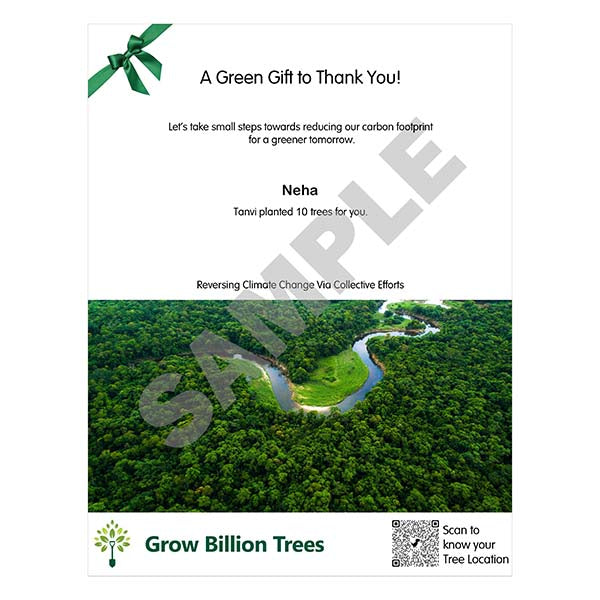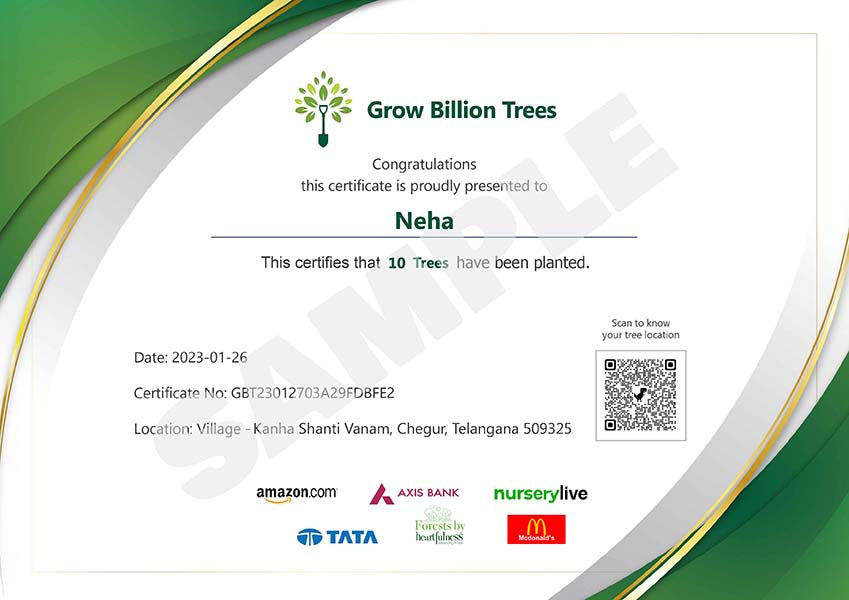


Description: Did you know that planting trees is a powerful way to combat climate change and reduce our carbon footprint? By absorbing carbon dioxide Read more
Description:
Did you know that planting trees is a powerful way to combat climate change and reduce our carbon footprint?
By absorbing carbon dioxide from the atmosphere and storing it in their wood, leaves, and roots, trees help to mitigate the greenhouse effect.
In addition to capturing carbon, trees offer numerous other environmental benefits, such as improving air quality, providing habitat for wildlife, and reducing erosion.
Scope:
- Enhancement of Biodiversity
- Increase in Green Cover
- Reduction of Man-Animal Conflict
- Generation of Rural Employment
- Improvement of Wildlife Habitats
Tree Species:
The species of trees that are planted depend on the project, and they are chosen based on their native habitat in the corresponding ecological zone.
Why trees?
Planting trees is an effective and natural way to help reduce our carbon footprint. Trees absorb carbon dioxide from the atmosphere and store it in their wood, leaves, and roots, which helps to mitigate the greenhouse effect and combat climate change.
In addition to capturing carbon, trees provide numerous other environmental benefits, such as improving air quality, providing habitat for wildlife, reducing erosion, and stabilizing soil. They also have the ability to beautify landscapes, provide mental health benefits, and create a sense of accomplishment.
By planting trees, individuals and communities can take an active role in offsetting carbon emissions and promoting sustainability. Whether you plant a tree in your own yard or donate to a tree-planting organization, this is a simple and impactful way to make a difference and reduce your carbon footprint. Every tree makes a difference, and together, we can make a significant impact on the health of our planet.
Social Impact:
Planting trees can have a number of social and community benefits, in addition to helping to reduce carbon emissions and combat climate change. Some of the ways in which tree planting can positively impact the community include:
-
Encouraging community involvement: Planting trees as a community activity can bring people together and promote social connections.
-
Fostering a sense of belonging: Participating in a tree-planting event can help to build a sense of ownership and pride in the community.
-
Promoting education and awareness: Tree planting can provide an opportunity for education and learn about the environment, raising awareness about the importance of trees and the role they play in the health and well-being of the planet.
-
Inspiring positive change: By planting trees and sharing the experience with others, you can inspire others to take action and make a positive impact on the environment. This can have a ripple effect, promoting sustainability and positive change in the community and beyond.
Overall, tree planting can be a meaningful and impactful way to contribute to the health and well-being of the community and the environment.
Carbon-Neutral Meeting Trees
Trees play a crucial role in achieving carbon neutrality for meetings by absorbing carbon dioxide from the atmosphere. These trees not only offset emissions but also provide additional environmental benefits such as improving air quality and enhancing biodiversity in meeting areas.
Carbon Sequestration
Meeting trees contribute to carbon sequestration by absorbing carbon dioxide during photosynthesis and storing it in their biomass. This process helps mitigate the greenhouse effect, combat climate change, and promote environmental sustainability for meeting venues.
Green Cover Benefits
Incorporating green cover into meetings offers numerous benefits, including creating a more natural and stimulating environment for participants. Green spaces have been shown to reduce stress, improve mood, and increase productivity, leading to more effective and enjoyable meetings.
Mitigating Man-Animal Conflict
Planting trees around meeting venues can help reduce conflicts between humans and wildlife by providing natural habitats and corridors for animals. This proactive approach fosters coexistence and harmony between people and wildlife while promoting biodiversity conservation.
Rural Employment Generation
Planting trees for meetings can create job opportunities in rural areas, contributing to local economic development and livelihood improvement. By engaging local communities in tree planting initiatives, meeting organizers can empower individuals and foster sustainable rural economies.
Wildlife Habitat Improvement
Meeting trees enhance wildlife habitats by providing food, shelter, and breeding grounds for various species. By planting trees in meeting areas, organizers can contribute to biodiversity conservation and promote the health and resilience of local ecosystems.
Native Tree Species
Using native tree species for meetings is essential for promoting ecological sustainability and resilience. Native trees are well adapted to local climate conditions and soil types, requiring less maintenance and resources while providing greater ecological benefits to meeting venues.
Community Engagement
Engaging local communities in planting trees for meetings fosters a sense of ownership, pride, and environmental stewardship. By involving community members in tree planting initiatives, meeting organizers can promote social cohesion and collective action for environmental conservation.
Educational Significance
Meeting trees offer valuable opportunities for experiential learning and environmental education. Participants can learn about the importance of trees in mitigating climate change, conserving biodiversity, and promoting sustainable land management practices.
Long-Term Impact
The long-term impact of meeting trees extends beyond carbon neutrality to encompass ecosystem health, resilience, and sustainability. By investing in tree planting initiatives for meetings, organizers can contribute to a greener future for generations to come.
FAQ
Why use trees for carbon-neutral meetings?
Trees serve as natural carbon sinks, absorbing carbon dioxide from the atmosphere during photosynthesis. By incorporating trees into meeting venues, organizers can offset carbon emissions from the event, promoting environmental sustainability and mitigating the impact of meetings on climate change.
How do meeting trees contribute to carbon sequestration?
Meeting trees absorb carbon dioxide from the atmosphere, storing it in their biomass. This process, known as carbon sequestration, helps mitigate the greenhouse effect, combatting climate change, and promoting environmental sustainability for meeting venues.
What are the benefits of green cover for meetings?
Green cover enhances meeting environments by providing natural aesthetics and creating a more comfortable and stimulating atmosphere for participants. Research shows that green spaces can reduce stress, improve mood, and increase productivity, contributing to more effective and enjoyable meetings.
How can meeting trees help mitigate man-animal conflict?
By providing natural habitats and corridors for wildlife, meeting trees can help reduce conflicts between humans and animals. Creating green spaces around meeting venues fosters coexistence and harmony between people and wildlife, promoting biodiversity conservation.
How do meeting trees contribute to rural employment generation?
Planting trees for meetings can create job opportunities in rural areas, contributing to local economic development and livelihood improvement. Engaging local communities in tree planting initiatives empowers individuals and fosters sustainable rural economies.
What role do meeting trees play in improving wildlife habitats?
Meeting trees enhance wildlife habitats by providing food, shelter, and breeding grounds for various species. By planting trees in meeting areas, organizers can contribute to biodiversity conservation and promote the health and resilience of local ecosystems.
Why is it important to use native tree species for meetings?
Native tree species are well adapted to local climate conditions and soil types, requiring less maintenance and resources while providing greater ecological benefits to meeting venues. Using native trees promotes ecological sustainability and resilience.
How does community engagement contribute to meeting tree planting initiatives?
Engaging local communities in tree planting for meetings fosters a sense of ownership, pride, and environmental stewardship. By involving community members, meeting organizers can promote social cohesion and collective action for environmental conservation.
What educational opportunities do meeting trees provide?
Meeting trees offer valuable opportunities for experiential learning and environmental education. Participants can learn about the importance of trees in mitigating climate change, conserving biodiversity, and promoting sustainable land management practices.
What long-term impacts can meeting trees have?
Meeting trees contribute to ecosystem health, resilience, and sustainability over time. By investing in tree planting initiatives for meetings, organizers can promote a greener future for generations to come, fostering environmental stewardship and conservation.



